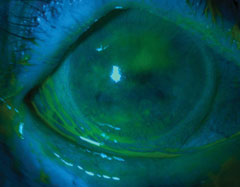 |
The contact lens practice is a mainstay within optometry today—nearly 34% of the average optometrist’s revenue is derived from contact lens services and materials.1,2 Much of our continuing education courses are devoted to properly fitting them and avoiding dropout. Millions of dollars are spent by industry to bring new polymers to the market.
Mistaken Identity
Despite this significant investment, why then does the typical practice still experience 16% of its contact lens patients dropping out of CL wear in their first year?1,2 Is it the type of contact lens polymer? The solution? The modality? Perhaps the better question is this: Does the CL wearer suffer from compromised ocular physiology and the OD isn’t properly evaluating the patient prior to the fit or refit of the lenses?
Far too often, we make the mistake of thinking it’s the contact lens, when in fact it is the ocular surface infrastructure creating the environment for successful CL wear. In the case of the contact lens patient with end-of-day discomfort, for instance, we should first investigate the ocular surface rather than simply switch solutions, modalities or polymers.
It’s On the Ocular Surface
Why discuss this in a coding column? Because misidentifying these fundamental issues puts many on the wrong path, leading further from properly identifying the clinical issues, creating the proper medical record and, ultimately, coding and billing for the appropriate procedures and conditions.
 |
| Identifying ocular disease, such as dry eye, is necessary to ensure CL success. Photo: Alan G. Kabat, OD and Joseph W. Sowka, OD. |
Generally, people associate contact lenses with refractive benefits through a managed vision care carrier because they provide coverage for refractive diseases and their prescriptive solutions. However, evaluating the problematic CL wearer has nothing to do with refractive disease—it has to do with ocular diseases such as dry eye and ocular allergy. Evaluating for ocular disease clearly creates a significantly different medical record. Using the appropriate office visit codes, either 920XX or 992XX, creates higher reimbursement for managing the episode of care due to the condition’s chronicity. That also means you would either collect copays or patients have to pay out of pocket to meet their deductible; but you are providing a different level of service, and your record must reflect that.
The Eye First, CLs Second
Regardless of who is financially responsible, it is your clinical duty to properly diagnose and treat both refractive and ocular disease. Unlike with refractive disease, assessing the structural and functional integrity of the ocular surface is a legitimate medical encounter. More importantly, you are evaluating the functional patency of the eye and ocular surface prior to determining the refractive solution for the patient. If the patient’s ocular surface is compromised in any way, simply changing the contact lens or the solution may only be alleviating the symptom, not truly addressing the problem.
My point is simple: don’t take the path of least resistance with your contact lens patients. It’s far too tempting not to explain their medical benefits, not to understand which level of 992XX code you performed, not to do the appropriate diagnostic testing to determine the underlying clinical condition, not to understand the ICD-10 system—but it doesn’t pay. So, don’t give in to temptation. Do the very best job you can, and that means performing a workup to better understand the ocular surface, and thus discover the underlying cause of the patient’s problems. By doing so, you will benefit from the consistent and correct application of medical eye care guidelines, creating happy patients and a better bottom line.
Send questions and comments to ROcodingconnection@gmail.com.
|
1. Rumpakis J. An International Perspective on Contact Lens Dropouts. Rev Optom. 2010;147(1):37-42. 2. Rumpakis J. The Economics of Apathy. Rev Optom. 2013;150(10):65-72. |

